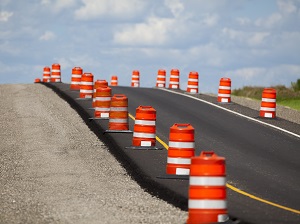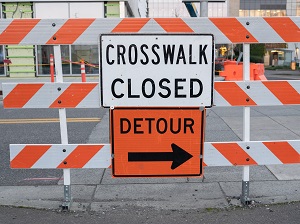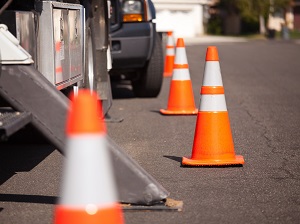Temporary traffic control signs and devices are an essential component of temporary traffic control effectiveness and overall work zone safety.

The main functions of temporary traffic control are 1) to provide safe and efficient guidance to road users, including drivers, cyclists and pedestrians, as they navigate through areas that are near work zones and 2) to protect workers and equipment in the work zone.
By communicating to drivers, the safe way to proceed through or around the work zone, a safer job site is created and serious hazards can be prevented. Signs and devices should be used in a way that get the motorist’s attention and provide easy to understand direction.
Before any detour is created, all necessary signs and devices should be in place. When work is suspended, signs and devices must be covered or removed and when work is completed, then they must be removed from the route.

Temporary traffic control (TTC) signs and devices must be installed and maintained in such a way that they maximize safety and minimize disruption to usual traffic patterns.
Channelizing devices, like cones, drums, vertical panels and tubular markers, are used when a change in the traffic pattern is necessary to protect the work zone, which may include guiding traffic:
- from one lane to another.
- onto a bypass or detour.
- into a narrower traveled way.
- away from the work zone.
- away from pavement drop-offs.
All temporary traffic control signs and devices must be:
- in conformance with the requirements of the MUTCD and State DOT standards.
- aligned with the road user’s line of sight.
- positioned in such a way that doesn’t obstruct any other traffic control devices.
- free of damage, stains, or fading.
- properly covered, turned, stowed or removed when not in use.
- visible during day and night operations.

Devices should always be used in a way that provide for smooth and gradually changing traffic flow.
Cones may be placed next to temporary traffic control signs for enhanced visibility. Take steps to minimize the possibility of cones being blown over or displaced by wind or traffic. Cones may be doubled up to increase their weight.
Drums are generally used in situations where they will remain in place for a prolonged period of time and should not be weighted down with sand, water, or other material to the extent that would make them hazardous to road users if struck.
Vertical panels, with diagonal orange and white stripes, shall be placed in a way that show the stripes sloping downward in the direction the traffic should pass.
Tubular markers should only be used where space restrictions do not allow more visible devices to be used and should be stabilized by affixing them to the pavement or adding weight to the base.

Warning signs should be placed at a location so that drivers can see the sign before they encounter the TTC zone. When multiple advance warning signs are needed, the Road Work Ahead sign should be the first sign that road users see.
MUTCD Standard 6F.02-14 All signs used at night shall be either retroreflective with a material that has a smooth, sealed outer surface or illuminated to show the same shape and similar color both day and night. 15 The requirement for sign illumination shall not be considered to be satisfied by street, highway, or strobe lighting.
Temporary traffic control (TTC) signs should be placed on the right-hand side of the roadway. When special emphasis is needed, signs may be placed on both sides of the road. Signs mounted on portable supports may be placed within the roadway. Signs may also be mounted on or above barricades. Sign supports should not be placed on areas designated for pedestrian or bicycle traffic.

MUTCD Standard 6F.63-18 Devices that are damaged or have lost a significant amount of their retroreflectivity and effectiveness shall be replaced.
The condition of traffic control devices is directly related to the level of safety they can provide for the work zone. If the devices are broken, faded, dirty or damaged there is a greater safety risk to the public and to the workers. Signs and devices should be properly maintained for cleanliness, visibility and correct positioning. Signs that have lost significant legibility should be promptly replaced.


